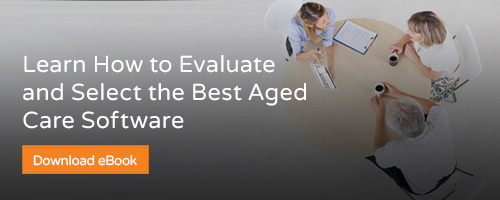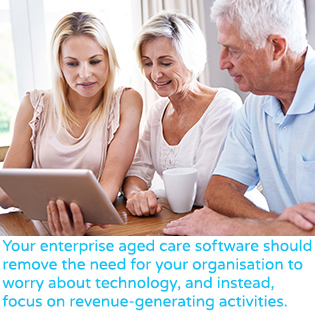Sure, printed documents still serve a functional place in modern business. However, running an aged care organization with a largely manual document management practice is not one such example.
Using aged care software to improve document management
Aside from the direct and indirect cost of storage, photocopying, retrieval and processing of paperwork, adopting a paperless document management process also delivers benefits in areas such as compliance, business continuity, and demonstration of social responsibility.
Allow me to provide a few practical examples of how software can drive such improvements.
The Smart Form Toolkit, as part of the Epicor Senior Living Solution (SLS), allows you to configure Smart Forms without custom development, which means you can create and index documents, and streamline business processes.
You can use Document Creation Smart Forms for everything from configuring new vendors to onboarding new employees. In each case, entering and tracking data, as well as viewing related documents, is a quick and straightforward process which yields both immediate and future benefits.
Consider your Accounts Payable (AP) process, a notoriously paper-intensive sequence of steps where multiple copies of documents are filed, retrieved, and distributed for approval. Automation technology, such as Epicor Content Management (ECM), can facilitate a significant streamlining of the AP process, as equally as it can also do for the Accounts Receivable (AR) process and management of General Ledger (GL).
ECM can capture the document in hard or soft copy, automate its distribution along with the necessary reports and forms, and make it available for easy access by anyone with the appropriate security rights.
When you free your operations from significant paper handling, month-end timeframes can be decreased, accounting department productivity can be increased, and you can free up staff time to focus on improving other processes to ensure that the organization is fit for growth.
IDC reports that digitally enhanced offerings will drive growth to a level whereby 60% or more of Australia's GDP will be digitized by 2021. Automation is one key player in the digital revolution and is a tool that aged care organizations should explore due to its ability to reduce human error and drive significant business efficiency. Moreover, if your aged care organization is not actively streamlining processes and information across the entire organization, the capacity for business decisions to be data-driven could be constrained.
Using aged care software to improve reporting
Your enterprise aged care software should remove the need for your organization to worry about technology, and instead, focus on revenue-generating activities.
The reality is that everything in the business spectrum moves at a rapid pace. Customer expectations, legislation, supplier processes, competitor offerings-nothing stands still for long. This constant change is one key reason why timely access to accurate data is imperative for effective business decision making.
A survey of over 3,000 CIOs by Gartner found that analytics and business intelligence were ranked by CIOs as the top differentiating technology.
Through utilising a leading enterprise aged care software solution, such as Epicor SLS, an abundance of data can be easily obtained in a contextualised manner, providing valuable insights for innovation and growth. Such insights can be displayed via dashboards that provide key information at-a-glance, promoting collaboration and inquisitiveness.
CFOs should be able to access data from either a single account or range of accounts across several business units, with functionality that allows them to drill down to a transactional level.
Staff across other departments should also be able to access reporting functionality specific to their roles, aiding them in performing their duties to the best of their ability.
A sophisticated reporting engine from a software system which facilitates Medicare claims and adapts to varied funding structures is particularly valuable for organizations which need to submit detailed compliance reports.
Moreover, when your systems are truly integrated, the depth of insight that can be gleaned from your analytics is also significantly improved. Effective integration facilities business decision making based on the whole story-giving senior managers confidence to act decisively.
 Deloitte University Press says that in the current business climate, "every company is now a technology company." This statement pertinently serves to suggest a necessary paradigm shift for those organizations who have not yet recognized the imperatives of adopting best-in-class technology solutions across their entire operation.
Deloitte University Press says that in the current business climate, "every company is now a technology company." This statement pertinently serves to suggest a necessary paradigm shift for those organizations who have not yet recognized the imperatives of adopting best-in-class technology solutions across their entire operation.
As I mentioned earlier, Australian aged care organizations exist in an industry which is continually changing. Therefore, if your enterprise aged care software solutions are static and your document management and reporting processes are time-consuming and labour intensive, then you are caught spending time managing software, not growing your business.
